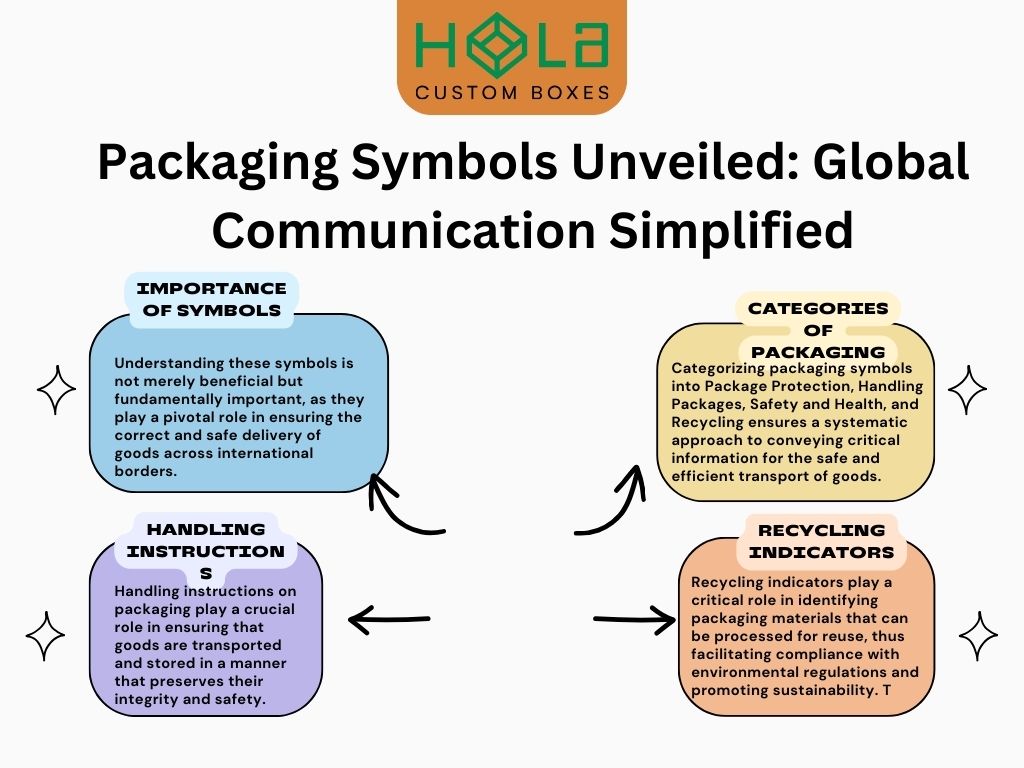Packaging Symbols Unveiled: Global Communication Simplified
2025-08-06 10:23:51
Standardized by the International Organization for Standardization (ISO), packaging symbols are vital for global communication, ensuring goods are correctly handled, transported, and stored. These symbols guarantee regulatory compliance, mitigate transportation hazards, and bridge language barriers. Categories include package protection, handling instructions, safety and health indicators, and recycling markers. They provide crucial guidance, such as indicating fragility, orientation, and potential hazards while also promoting environmental responsibility. For professionals in logistics, manufacturing, or regulatory sectors, understanding the nuances of these symbols can streamline operations, enhance safety, and promote sustainability. Continue discovering how these symbols simplify international logistics.
Main Points
- Packaging symbols bridge language gaps, ensuring global understanding and compliance with handling and transportation requirements.
- These symbols reduce transportation-related hazards by providing clear, standardized instructions for handling and care.
- Regulated by ISO, packaging symbols ensure the safe transit of goods by indicating protection needs and handling instructions.
- Safety and health symbols highlight potential hazards, promoting responsible logistics practices and regulatory compliance.
- Recycling symbols identify recyclable materials, aiding manufacturers and consumers in promoting global recycling efficiency.
Understanding Packaging Symbols

When it comes to international trade and logistics, understanding packaging symbols is paramount as they provide a universal method for identifying the contents and handling requirements of packages, irrespective of language barriers.
These symbols, meticulously standardized and overseen by the International Organization for Standardization (ISO), offer the first crucial indication of what is inside a package. Before their application, symbols must be thoroughly registered with ISO to ensure global uniformity.
A wide array of symbols exists, each tailored to different types of goods, thus facilitating accurate and efficient communication across diverse linguistic and cultural landscapes. Their precise use is essential for the seamless flow of goods, ensuring they are handled and transported correctly from origin to destination.
Crucial Role of Packaging Symbols in Global Trade
Understanding packaging symbols is essential for the safe and efficient delivery of goods across international borders. These symbols act as a universal language, enabling clear communication of handling and storage instructions regardless of language or location. By doing so, they help prevent misunderstandings and ensure that products are managed correctly throughout the shipping process.
Enhancing Safety and Compliance Through Symbols
Beyond communication, packaging symbols play a vital role in mitigating transportation risks. They help protect goods by indicating specific safety requirements and handling precautions, which reduces the chance of damage. Additionally, these symbols support compliance with international regulations, making them indispensable for businesses engaged in global trade.
| Benefit | Explanation |
|---|---|
| Risk Mitigation | Reduces transportation-related hazards through clear instructions. |
| Regulatory Compliance | Ensures adherence to international shipping laws and standards. |
| Universal Communication | Bridges language gaps, ensuring understanding across diverse regions. |
| Consumer Safety | Informs consumers of potential hazards, ensuring safe usage. |
| Efficient Handling | Guides handlers on proper methods, minimizing damage during transit. |
Effective use of symbols is essential for maintaining the integrity of international shipments.
Categories of Packaging Symbols
Categorizing packaging symbols into Package Protection, Handling Packages, Safety and Health, and Recycling ensures a systematic approach to conveying critical information for the safe and efficient transport of goods. This categorization not only enhances clarity but also ensures compliance with international regulatory standards. Each category serves a unique function:
Package Protection: Indicates measures to prevent damage during transit.
Handling Packages: Provides instructions for proper handling to avoid mishandling.
Safety and Health: Alerts to potential hazards and necessary safety precautions.
Recycling: Communicates the recyclability of the packaging materials.
This structured approach ensures that all stakeholders, from manufacturers to end-users, understand the necessary precautions and procedures, thereby facilitating a seamless global logistics operation.
Package Protection Symbols
Package Protection symbols are critical indicators designed to prevent damage to products during transportation. These symbols, regulated by the International Organization for Standardization (ISO), communicate essential information to ensure the safe transit of goods.
Notable symbols include the umbrella for indicating a need to keep the package dry, the glass symbol for fragile items, and the thermometer for temperature-sensitive products. These indicators not only safeguard the integrity of the contents but also ensure compliance with international shipping regulations.
Proper usage of these symbols mitigates the risk of mishandling and reduces potential financial losses due to damaged goods. Therefore, understanding and correctly applying package protection symbols is paramount for efficient and secure global logistics.
Handling Instructions
Handling instructions on packaging play a crucial role in ensuring that goods are transported and stored in a manner that preserves their integrity and safety. These symbols provide critical guidance to handlers and logistics personnel, ensuring that packages are treated according to specific requirements to avoid damage or degradation.
Key handling instructions include:
- Fragile: Indicates that the contents are breakable and should be handled with care.
- This Way Up: Specifies the correct orientation to prevent mishandling.
- Keep Dry: Advises protection from moisture to maintain package integrity.
- Temperature-Sensitive: Indicates the necessity for controlled temperature during transport and storage.
Adherence to these symbols is vital for compliance with international shipping regulations and maintaining product quality.
Safety and Health Symbols
In the realm of international packaging, Safety and Health symbols are crucial for indicating environmental hazards and necessary precautions to ensure the safe handling and transport of goods. These symbols, governed by international standards such as ISO 780, provide clear and concise warnings about contents that may pose risks to health, safety, or the environment.
Typical symbols include those for flammable, toxic, corrosive, and radioactive materials. Compliance with regulatory requirements like the Globally Harmonized System (GHS) for labeling hazardous substances is mandatory.
Detailed and standardized, these symbols not only assist in mitigating potential accidents but also ensure that handlers are aware of the specific dangers associated with the materials, thereby promoting responsible and secure logistics practices worldwide.
Recycling Indicators
Recycling indicators play a critical role in identifying packaging materials that can be processed for reuse, thus facilitating compliance with environmental regulations and promoting sustainability. These symbols are essential for both manufacturers and consumers, ensuring that materials are correctly segregated and processed.
Key recycling indicators include:
Möbius Loop: Represents that the packaging is recyclable, sometimes with a percentage indicating recycled content.
Green Dot: Signifies that the producer has made a financial contribution to recycling efforts.
Resin Identification Code: Indicates the type of plastic material, aiding in appropriate recycling stream categorization.
Glass Recycling Symbol: Specifies that the material is recyclable glass, ensuring correct disposal and processing.
Understanding these symbols enhances global recycling efficiency and supports regulatory adherence.
Additional Information
Beyond recycling indicators, there is a breadth of additional information vital for the comprehensive understanding and application of packaging symbols in various industries. These symbols encompass guidelines for handling, storing, and shipping, ensuring that packages receive appropriate care and attention throughout the logistics chain.
Regulatory compliance often necessitates adherence to specific symbols to prevent mishandling and to safeguard both handlers and recipients from potential hazards. Moreover, specialized symbols serve as critical markers for sensitive contents, such as perishable goods, hazardous materials, and fragile items.
For comprehensive support and expert recommendations tailored to secure shipping practices, industry professionals may consult resources like The Custom Boxes, which offers detailed guidance and ensures privacy protection for all customer interactions.
